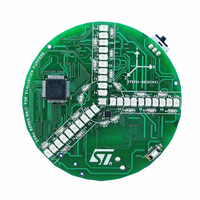STEVAL-MKI030V1 STMicroelectronics, STEVAL-MKI030V1 Datasheet - Page 87

STEVAL-MKI030V1
Manufacturer Part Number
STEVAL-MKI030V1
Description
BOARD DEMO STM8S207R6/LIS331DLH
Manufacturer
STMicroelectronics
Series
MEMSr
Datasheets
1.STEVAL-MKI009V1.pdf
(42 pages)
2.STEVAL-MKI022V1.pdf
(38 pages)
3.STEVAL-MKI030V1.pdf
(105 pages)
4.STEVAL-MKI030V1.pdf
(4 pages)
Specifications of STEVAL-MKI030V1
Design Resources
STEVAL-MKI030V1 Schematic
Sensor Type
Accelerometer, 3 Axis
Sensing Range
±2g, 4g, 8g
Interface
I²C, SCI
Sensitivity
3.9mg/digit, 2mg/digit, 1mg/digit
Voltage - Supply
4.5V
Embedded
Yes, MCU, 8-Bit
Utilized Ic / Part
LIS331DLH, STM8S207R6T6
Sensing Axis
Triple Axis
Operating Voltage
5 V
Lead Free Status / RoHS Status
Lead free / RoHS Compliant
Other names
497-8852
STM8S207xx, STM8S208xx
10.3.11
EMC characteristics
Susceptibility tests are performed on a sample basis during product characterization.
Functional EMS (electromagnetic susceptibility)
While executing a simple application (toggling 2 LEDs through I/O ports), the product is
stressed by two electromagnetic events until a failure occurs (indicated by the LEDs).
●
●
A device reset allows normal operations to be resumed. The test results are given in the
table below based on the EMS levels and classes defined in application note AN1709.
Designing hardened software to avoid noise problems
EMC characterization and optimization are performed at component level with a typical
application environment and simplified MCU software. It should be noted that good EMC
performance is highly dependent on the user application and the software in particular.
Therefore it is recommended that the user applies EMC software optimization and
prequalification tests in relation with the EMC level requested for his application.
Software recommendations
The software flowchart must include the management of runaway conditions such as:
●
●
●
Prequalification trials
Most of the common failures (unexpected reset and program counter corruption) can be
recovered by applying a low state on the NRST pin or the oscillator pins for 1 second.
To complete these trials, ESD stress can be applied directly on the device, over the range of
specification values. When unexpected behavior is detected, the software can be hardened
to prevent unrecoverable errors occurring (see application note AN1015).
Table 47.
Symbol
V
V
FESD
EFTB
ESD: Electrostatic discharge (positive and negative) is applied on all pins of the device
until a functional disturbance occurs. This test conforms with the IEC 61000-4-2
standard.
FTB: A burst of fast transient voltage (positive and negative) is applied to V
through a 100 pF capacitor, until a functional disturbance occurs. This test conforms
with the IEC 61000-4-4 standard.
Corrupted program counter
Unexpected reset
Critical data corruption (control registers...)
Voltage limits to be applied on any I/O pin to
induce a functional disturbance
Fast transient voltage burst limits to be
applied through 100pF on V
to induce a functional disturbance
EMS data
Parameter
Doc ID 14733 Rev 11
DD
and V
SS
pins
V
f
conforming to IEC 61000-4-2
V
f
conforming to IEC 61000-4-4
MASTER
MASTER
DD
DD
5 V, T
5 V, T
16 MHz,
16 MHz,
Conditions
A
A
25 °C,
25 °C,
Electrical characteristics
DD
Level/class
and V
2B
4A
87/105
SS



















